Tabbed out on the Oregon Trail
Friday, August 30, 2024
Comments: 11 (latest 19 hours later)
Tagged: oregon trail, jesse wiley, books, meanwhile, cyoa
Powell's is rightly famed as a destination for book lovers, and I finally made my pilgrimage last weekend. The perils of air travel limited the inevitable splurge -- I had to fit my haul into a single backpack -- but I wound up with some nifty volumes. Including this surprise:
The world is awash with choice-based gamebooks, each with its own clever paraphrase of "choose your own you-know-what". A book based on the old Oregon Trail idea isn't a surprise.
No, the surprise is that bit about "tabbed pages". Tabbed?
Yep! This isn't a "turn to page 8" gamebook. It's a pipe-and-tab gamebook, which is a very uncommon format. Meanwhile is the first and, I thought, the only example. Here's a second book that does it!
Let's back up a bit, though.
The Oregon Trail (1971) is one of the earliest narrative text games. Heck, one of the earliest computer games. Jimmy Maher and Aaron Reed have ably documented its history.
...Yeah, you got distracted reading those posts. (I sure did!) But you're back now.
The Oregon Trail is an evergreen concept. Various ports and remakes appeared through the 80s and 90s. In 2008, a studio called Gameloft got the license from the publisher that held it. (HarperCollins seems to have scooped the "Oregon Trail" trademark in 1992. Or maybe it was Houghton Mifflin at that point? I haven't dug into the murky web of book industry oligopolization.)
Gameloft released their version for a variety of mobile platforms. These days it's on Steam and other stores and consoles. I haven't played it, but it seems like a straightforward modernization of the original sim-game concept. More gameplay, more narrative, more historical detail, sweet graphics. Fine.
Around 2018, some bright spark got the idea of doing CYOA books as a spin-off. The first four of these form a sequence, taking you from Missouri to Oregon in four chapters. They must have sold pretty well because the publisher did four more after that.
These eight are not tabbed gamebooks. They're regular old "turn to page N" style, plain text with small illustrations. (The illustrations have a cheerfully 8-bit pixel style. Way more pixelated than the computer game, I was amused to note.)
The books themselves don't credit an author; they just say "Copyright 2018 by HMH IP Company" (Houghton Mifflin Harcourt). But the current publisher page credits "Jesse Wiley". Wiley doesn't seem to have any internet presence beyond the series. Might be a person, a pen name, or a syndicate alias like "Carolyn Keene". More info welcome!
Then, aha, in 2020, a new volume appears! Pick Your Own Path on The Oregon Trail. Same branding, same attribution. (Except the publisher is HarperCollins now.) But this one is printed in full color -- with panels, pipes, and tabs.
Note that this is not a graphic novel like Meanwhile. The panels are plain text. The pages are illustrated with the same pixel-clip-art as the earlier books, albeit colorized; but it's not sequential art. But, by the same token, there's much less text per page than a "normal" book. The textual Oregon Trail gamebooks have rich narrative scenes, with named characters and everything. In this one, the text is trimmed down to a couple of tight sentences per panel.
Have I gotten across how peculiar this is? Tabbed books are not easy to do! They are expensive to print because of the die-cutting. The paper needs to be very heavy coated stock to prevent the tabs from tearing. It's color printing. Okay, probably the color printing is free once you've committed to the heavy stock, but still -- expensive.
Also, the layout is a pain in the ass. I would not, offhand, know how to solve the problem of turning a state diagram into a die-cuttable stack of tabs. Jason Shiga's note on Meanwhile says:
...the problem proved to be NP-complete. With the use of a V-opt heuristic algorithm running for 12 hours on an SGI machine, the solution was finally cracked in spring of 2000. It was another six months before layouts were finished, again with the aid of homebrew computer algorithms.
Of course a circa-2000 SGI workstation isn't much by modern standards. And Meanwhile is a far more complex book than Oregon Trail. (Oregon Trail has 26 pages, 76 panels, and 10 tab rows. Meanwhile has 37 pages, 710 panels, and 11 tab rows.)
Still, it's a bunch of work, and it's not obvious that the result is more fun than a standard CYOA gamebook. I mean, I'm super excited, but I'm not the target audience! Your typical game-playing kid might not even think about the difference in format, except to say "Huh, no names."
So what's the book like? I should talk about the book. It's rather simple, as gamebooks go.
As you see, there's two big branches. (The "leave in March or May?" choice above.) Each branch is your basic gauntlet pattern. Do everything right, you live. Do anything wrong, you die. Yes, you can die of dysentery, not to mention cholera, typhoid, hypothermia, and bear.
In total there are 25 failures and three victory states. I'm not sure why the cover says "more than 50 possibilities!" but those numbers are never very meaningful. I suppose you could count the number of distinct paths that lead to victory. I see just eight, and they don't vary much beyond the three endpoints.
There's exactly one "walking dead" node, where you're certain to die but you don't know it yet. Everywhere else, if you make a bad choice, you turn the page and read your death scene. That very first choice -- "are you ready to start?" sure sets the tone.
Or... does it? It conveys that every mistake is immediately fatal. But it also conveys that the author is out to get you. "Ha ha, rattlesnake!" It's not exactly a logical consequence. Maybe it should have said, "You stay home, which is safe but boring. Your journey ends here never starts."
The chart has a couple of small loops, and these don't make much narrative sense either. Making the same mistake over and over is silly, of course. But also the loops include time travel! You can leave Chimney Rock on May 2, run out of food, and double back to Chimney Rock, losing "four weeks of travel" -- but you return to the same May 2 panel you started at. The other loop has a similar date failure. (The designers missed the obvious opportunity to kick you over to the other branch, which has later dates!)
As for the story... well, the book is not a searing indictment of colonialism. There is no historical context. It doesn't even mention why you're going to Oregon! On the up side, the book avoids stigmatizing the Native Americans that appear. Given the extreme brevity of the text, it hardly counts as a nuanced portrayal, but at least it mentions real First People nations and it doesn't make them bad guys. In fact this book has very few bad guys. Aside from one bandit ambush, you will generally die of stupidity or natural causes. Stupidity and natural causes, I should say.
(I believe the earlier textual CYOA books in this series have more historical depth. You meet and travel with Native American characters -- named characters! -- so there must be some context written in. I don't know how much, though.)
The book tries to stick to a realistic portrayal of good decisions and bad decisions. (Do not cheap out on repairs. Do not run away from the bear. Etc.) Inevitably, though, there are a lot of "left or right? whoops not left" decision points. I already mentioned the initial choice. For another example, both branches have a choice of the form "take Barlow Road or raft down the Columbia River?" The wrong answer kills you, but the two versions of the choice have different wrong answers.
(I suppose it makes sense that the correct answer depends on the season? That is, the date when you arrive. But the text doesn't have enough info to make this a solvable puzzle.)
(These two Barlow/Columbia choice panels are on the same page, by the way. I'm sure this is a nod to Meanwhile's brilliant narrative use of side-eye.)
(Yes, the Barlow Road was named for Sam Barlow. The mighty Oregon Trail pioneer, that is.)
Are there any other tab-format gamebooks out there? How did this one come to be? Who decided it was a format worth imitating? Who is Jesse Wiley? I'm desperately curious to know!
Yes, I asked Jason Shiga. He wasn't aware of this book either.
If I learn anything, I'll attach it here.
Comments from Mastodon
@zarfeblong nice. I was about to “well actually Adventureland Comics”, but I had forgotten that Shiga returned to numbered sections for those books.
@ianholmes Indeed!
(I’ve got “The Beyond” in front of me right now...)
"I would not, offhand, know how to solve the problem of turning a state diagram into a die-cuttable stack of tabs."
I wonder if this is a small enough book that it could have just started with a little pile of paper with tabs on them and going from there. Sketch in the outline of the events, run through it, make sure it mostly makes sense, then start doing all the art and text and layout.
@anthracite The problem is deciding which pages have tabs in which rows. Of you want to jump ahead three pages, you need to have three pages *without* a tab (in a given row) followed by one page *with* a tab. This turns into a funny sort of circuit-routing problem.
Oh yeah, that's super complicated to figure out if you build the story before you build the maze! I'm just saying that building the route *first* and then plugging in content might be less effort than building the flowchart and *then* figuring out how to make it work.
Like this:
1. get a ring binder and some paper and a whole lot of colored tabs
2. arrange the tabs largely at random
3. write "start game" on spread 1, write "you win" on the last spread
3. map out a path through the links suggested by the tabs that takes you through about half the book
4. write an Oregon Trail Problem like "you meet a bear, shoot it or run?" on a middle page, pick two likely-looking visible tabs, see if there's anything on their corresponding pages, if not then write "the bear eats you" on one page, "you eat the bear" on the other.
5. repeat step 4 with other Oregon Trail Problems until every spread has something on it.
6. maybe go through and prune tabs that are never used, maybe just put funny dead ends next to them if there's space on the pages, whatever fits
7. turn this ratty pile of pages and tabs into finished art and prose
Build the multi-page maze *then* write your story on its walls, instead of planning the shape of the story and building the maze to match it.
@anthracite Oh, I see. That could work, but I don’t think that’s what we’re looking at here. It feels like a top-down design.
I do wonder if the tiny loops were originally more interesting but they couldn’t make the original plan work. That’s the clumsiest bit of the design.
@anthracite Specifically I suspect that a random arrangement of tabs would be inefficient. You would wind up not using a lot of them. In this book, almost every tab has an active pipe on it. And most of the exceptions are “backwards” (left-side) tabs in the second half of the book — which is because the book is generally forward-flowing.
yeah, I'm kinda just pondering the shape of this general problem without having more than the three spreads of this specific example that you excerpted to look at. Kinda tempted to stop at Office Depot on the way home for some paper and tabs but I already have more than enough side projects to deal with.
I just feel like there's a workflow here that explicitly acknowledges the *physical object* being created at a much earlier part of the process than the "flowchart -> comics pages -> omfg how do I make these page turns actually work" process that seems to be what Shiga did for Meanwhile.
@zarfeblong if i were approaching this project(with this kind of design and scope) it would probably be done by opening up an image editor with layers, building a setup with one page = one layer, then start allocating the pages and pipes by hand in a naive start-to-finish, breadth-first fashion. The nature of Oregon Trail is to use episodic units, so the specifics only rest on the basic "starting month, ending month, landmarks" plots.
Since the content of the story follows roughly the same degree of progression along each branch, it can be visually layer-grouped to remove everything but the adjacent sections, making it possible to work iteratively in small sections, and accumulate the visual design as you proceed forward. The simplest pipe allocation would just use a unique tab for each, but the author could decide to improvise their design around a fixed number and just stop branching wider at that point in the story.
This method would also explain the errors with loops, because this method, being focused on going directly to graphics, would also omit playtesting the structure.
@Triplefox This book is really too simple to have an episodic structure. I suspect they just laid the whole thing out by hand — “naive” is right — but I still think the structure came first. (That’s how the first eight books must have been done, after all.)
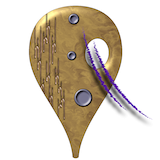

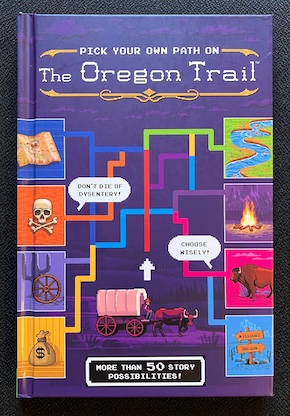
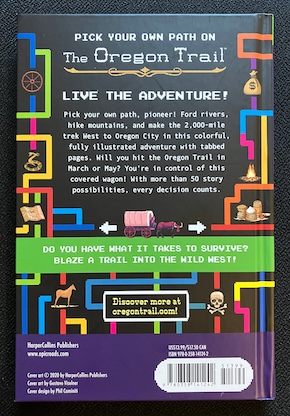
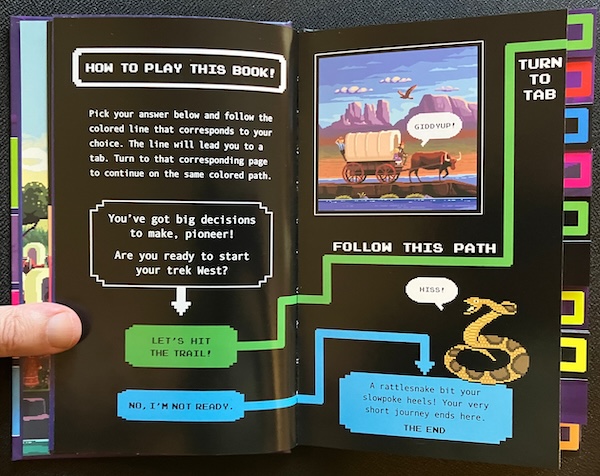
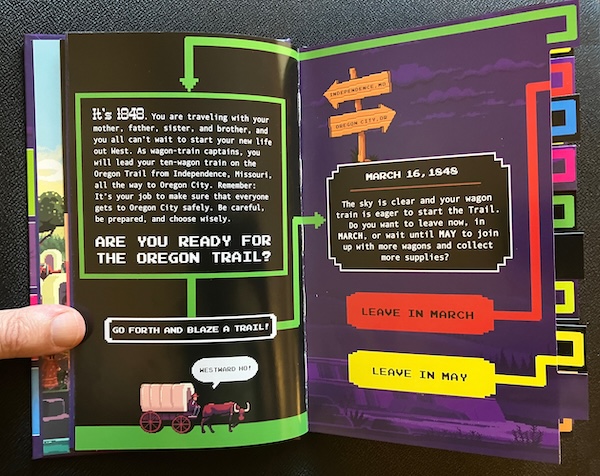
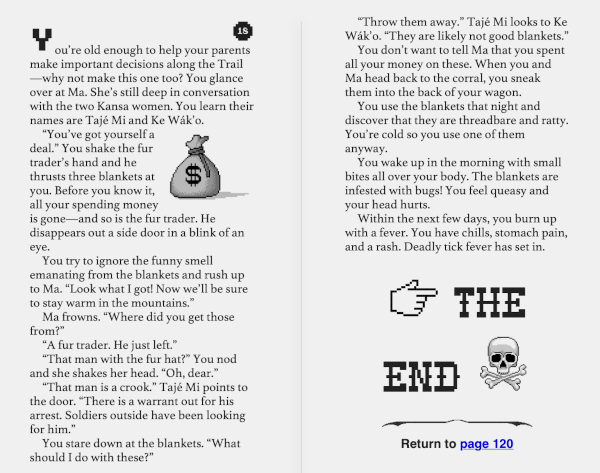

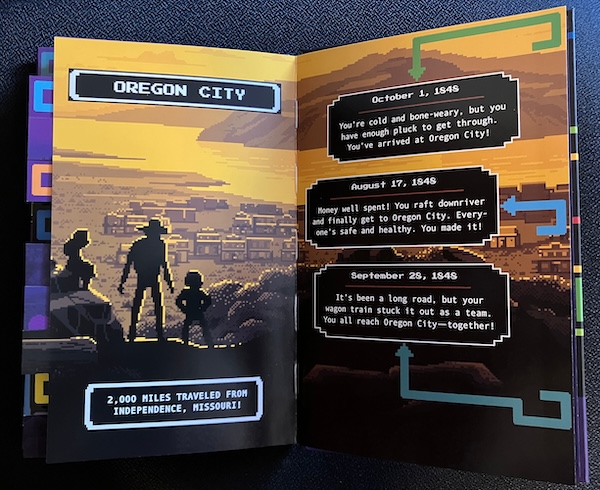
@zarfeblong thanks for posting about this, it looks like an interesting little implementation of the classic.